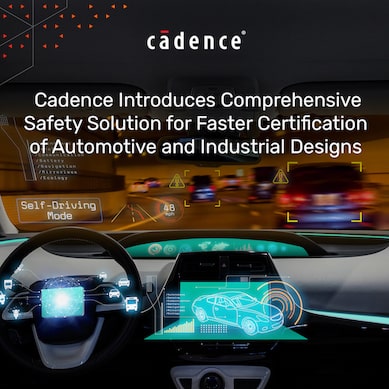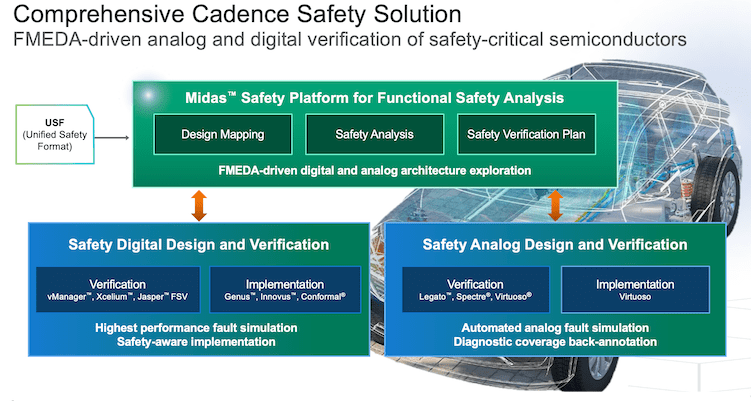This is another level-up story, a direction I am finding increasingly appealing. This is when a critical supplier in the electronics value chain moves beyond islands of design automation to provide an integrated solution for the front-to-back design for capabilities now essential for automotive and industrial automation clients. For whom safety must run through all the design process. In coverage, adding safety coverage. Integrating digital and analog fault campaigns. In automated safety mechanism insertion and verification. In optimizing verification engines (digital and analog) for maximum parallelism and throughput. Intelligent fault list reduction. And, in some ways most important, in providing an accessible status portal for safety managers to view design-for-safety status without need for EDA tool expertise.

Why is a front-to-back solution important?
The boom in ADAS and safety features isn’t simply because ADAS features are cool and safety is generally a good thing. The European New Car Assessment Program (Euro NCAP) has been tracking new car introductions on several fatality metrics, for adult and child occupants for example, rating cars on a 5-star system against several safety tests. These ratings are generally available and have had a startling positive impact on road fatalities over a decade or more. Auto makers are putting heavy emphasis on further advanced ADAS features since these ratings are directly affecting the saleability of their products.
Those needs then ripple down the supply chain, increasing emphasis on higher ASIL certifications and fail-operational implementations. The latter require safety islands to monitor in-operation integrity and ability to isolate out-of-spec circuitry. Which increases need in design to explore tradeoffs in safety mitigation techniques, to have robust safety planning and analysis, very effective and efficient fault campaign support across digital and analog circuitry and the means to roll all that back up to the top level FMEDA plan. These needs, together with early customer feedback, have guided Cadence’s development of their safety solution.

The solution architecture
Frank Schirrmeister (Senior Group Director, Solutions at Cadence) told me how to think of this. As a technology horizontal (safety in this case) across vertical markets. This horizontal integrates across three of the five Cadence domains: digital and analog implementation, and verification, with an intent to get to faster safety certification for automotive and industrial designs.
At the top level is a new tool, the Midas Safety Platform, driving management of the FMEDA campaign and providing a unified interface to all underlying Cadence engines. Primary users of this platform would probably be architects, safety managers and product managers. People who don’t want to get into the details of understanding and running those underlying tools but who do want to be able to extract useful information. To experiment with options and assess current safety status. The tool runs on both Windows and Linux for this reason. It manages internally the complexity of gathering such data from the domain tools. Midas also supports USF, a Unified Safety Format to exchange and manipulate safety information across different Cadence tools.
The digital safety design platform incorporates multiple improvements in support of this release. vManager now has safety-centric capabilities. Xcelium has been further optimized for serial and concurrent fault simulation. Xcelium-ML is also fault simulation-aware to reduce regression run-times. Implementation choices for safety mitigation, user-specified from the top, are implemented through Genus synthesis and validated through Conformal equivalence checking.
The analog/AMS functional safety flow has been developed in alignment with the IEEE P2427 proposed standard. The flow integrates Spectre for simulation and Legato for reliability, adding a new fault assistant for rule-based fault identification. The solution automates launching fault simulations for different failure modes. It also accelerates functional safety closure by annotating safety diagnostics back to Midas.
Customer validation
Cadence has been working with multiple customers to validate and refine this solution and have several public endorsements. The Arm automotive and IoT line of business has endorsed the solution. Hailo, a well-respected AI at the edge company and Melexis, a European manufacturer of semiconductor products, both used in automotive designs ,are on board. And ST, widely known for industrial solutions and sensing expertise has provided endorsement. Pretty solid backing.
You can learn more about the Cadence Safety Solution HERE.
Also Read
An ISA-like Accelerator Abstraction. Innovation in Verification
Accelerating Exhaustive and Complete Verification of RISC-V Processors
Side Channel Analysis at RTL. Innovation in Verification
Share this post via:





Comments
There are no comments yet.
You must register or log in to view/post comments.